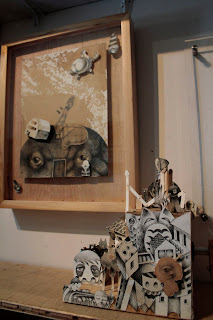
Tuesday, March 20, 2012
Monday, March 19, 2012
"LIVING ROOM", Artist In Residence, Koganecho Yokohama Japan

Papermoon Puppet Theatre, headed by visual artist Iwan Effendi and playwright Ria Sulistyani, reaches far beyond the traditional and explores the possibilities of puppetry through productions made with creators from a wide variety of fields. The voiceless Papermoon puppets, charming yet expressing an air of unease in their faces, do not limit themselves to stage performances, but also make appearances in the everyday spaces around us. With both light and dark undertones, the performances present a scathing criticism of social authority, all the while conveying hope in the power of the individual.
In addressing the Living Room theme, Papermoon transformed the second floor of an old house into an interactive installation piece by pursuing the traces of the past left in the wooden structure’s walls and beams. In a way, the space represented a meeting place where people, objects, and the past, present and future encounter each other. A hanging puppet greets the “audience” as they begin their ascent up the stairs, and once reaching the top, find a troupe of small, headless marionettes dancing before their eyes. An enormous, larger than life puppet with long, dangling limbs occupies one corner of the room. Sprite-like creatures peep curiously at spectators from the wooden posts scattered about the space. The body of a single marionette lays encased inside an incubator-like box, next to which on an earthen wall that looks as if it could crumble down at any moment, hangs a scrolling floral motif painting. Lastly, in the far corner, there stand the miniature, white buildings of a fictional town.
The “stage” does not provide the audience with any pre-conceived scenario. Instead, the story begins when observers first step into the room and begin to interact with the objects and puppets, bringing the space to life each with his or her own memories and power of imagination. In this way, the puppets who silently await our arrival, present not a one-sided tale, but rather open to us the possibilities of interactive storytelling.
Mayumi Hirano, Koganecho Area Management
all photo by: Yasuyuki Kasagi






















